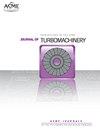1.5级高功涡轮非定常流动CFD模拟
IF 3.1
3区 工程技术
Q3 ENGINEERING, MECHANICAL
引用次数: 0
摘要
Behr等人对1.5级高功涡轮的非定常流动和时钟效应进行了实验研究。他们的试验台第一排定子有36个叶片,一个54个叶片的转子,转速为2700转/分,第二排定子有36个叶片。他们研究了四种不同的定子计时位置。本文利用Simcenter STAR-CCM+软件对1.5级涡轮的非定常流动进行了计算研究。模拟的数学模型由非稳态质量、动量和能量方程组和海温湍流模型组成。在将计算结果与实验数据进行比较之前,作者对计算结果进行了质量评估程序。他们使用网格收敛指数(GCI)报告了数值精度。结果表明,非稳态计算效率比稳态计算效率高,使数据和模拟更接近。转子和第二定子出口平面的总压曲线与实验结果吻合较好。最后,对不同定子时钟位置的影响进行了仿真。结果表明,定子时钟位置的变化与实验结果相似。本文章由计算机程序翻译,如有差异,请以英文原文为准。
CFD SIMULATIONS OF THE UNSTEADY-STATE FLOW THROUGH A 1.5-STAGE HIGH-WORK TURBINE
Abstract Behr et al. [1] have experimentally investigated the unsteady-state flow and clocking effects in a 1.5-stage high-work turbine. Their test rig had a first stator row with 36 blades, a 54-bladed rotor at 2,700 rpm, and a second stator row with 36 blades. They studied four different stator-clocking positions. The present paper computationally investigates the unsteady-state flow through the 1.5-stage turbine by performing CFD simulations with the Simcenter STAR-CCM+ software. The mathematical model of the simulations consisted of the ensemble-averaged unsteady-state mass, momentum and energy equations complemented by the SST turbulence model. The authors applied a quality assessment procedure to the computational results before comparing them to the experimental data. They reported the numerical accuracy using the Grid Convergence Index (GCI). The results showed an increase in the calculated efficiencies of the unsteady-state over the steady-state results, bringing data and simulations closer. The total pressure contours at the rotor and second stator exit planes also agreed well with the experiments. Finally, the paper includes simulations of the effects of different stator-clocking positions. The results showed a similar response to the change in stator-clocking position as the experiments.
求助全文
通过发布文献求助,成功后即可免费获取论文全文。
去求助
来源期刊
CiteScore
4.70
自引率
11.80%
发文量
168
审稿时长
9 months
期刊介绍:
The Journal of Turbomachinery publishes archival-quality, peer-reviewed technical papers that advance the state-of-the-art of turbomachinery technology related to gas turbine engines. The broad scope of the subject matter includes the fluid dynamics, heat transfer, and aeromechanics technology associated with the design, analysis, modeling, testing, and performance of turbomachinery. Emphasis is placed on gas-path technologies associated with axial compressors, centrifugal compressors, and turbines.
Topics: Aerodynamic design, analysis, and test of compressor and turbine blading; Compressor stall, surge, and operability issues; Heat transfer phenomena and film cooling design, analysis, and testing in turbines; Aeromechanical instabilities; Computational fluid dynamics (CFD) applied to turbomachinery, boundary layer development, measurement techniques, and cavity and leaking flows.

 求助内容:
求助内容: 应助结果提醒方式:
应助结果提醒方式:


